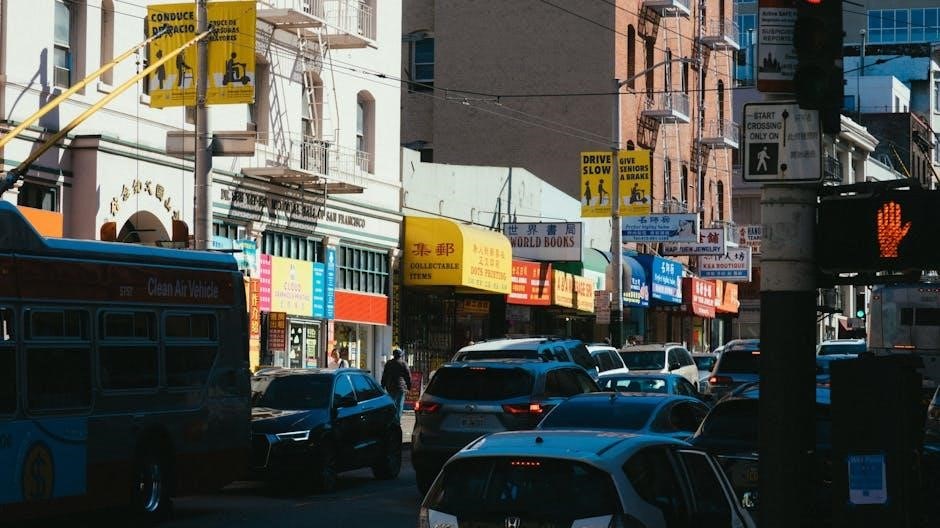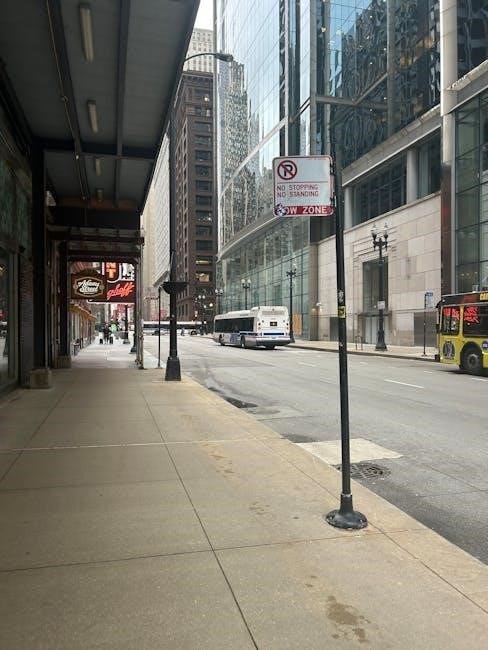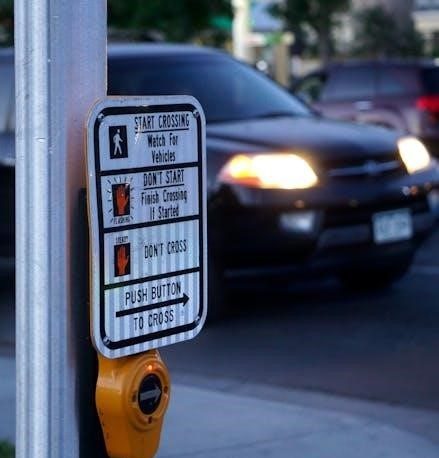The Traffic Signs Manual Chapter 6 provides essential guidance on traffic control, focusing on designing signalized junctions and pedestrian crossings in urban areas with speed limits under 40 mph.
1.1 Overview of Chapter 6
Chapter 6 of the Traffic Signs Manual focuses on traffic control measures, providing guidance on the design of traffic signal junctions and pedestrian crossings. It is specifically tailored for urban areas with speed limits of 40 mph or less. The chapter serves as a critical resource for traffic authorities, designers, and contractors, ensuring compliance with traffic regulations. It covers key aspects such as signal design, phasing, and timing, as well as safety considerations for junctions and crossings. The manual emphasizes the importance of clear and consistent traffic control to maintain efficient and safe traffic flow. By adhering to the guidelines in Chapter 6, professionals can design infrastructure that prioritizes road safety and user convenience, aligning with broader traffic management goals across the UK.
1.2 Purpose and Scope of Traffic Control
The primary purpose of traffic control, as outlined in Chapter 6, is to ensure the safe and efficient movement of road users, including vehicles, pedestrians, and cyclists. The scope of traffic control measures extends to urban areas with speed limits of 40 mph or less, where signalized junctions and crossings are most critical. The manual provides guidance on designing traffic signals, managing signal phasing, and ensuring compliance with the Traffic Signs Regulations. It serves as a resource for traffic authorities, designers, and contractors, offering practical advice on implementing effective traffic control strategies. By adhering to the principles outlined in Chapter 6, stakeholders can create balanced road networks that prioritize safety, efficiency, and accessibility. The manual also emphasizes the importance of clear communication through traffic signs and road markings to guide road users effectively.
1.3 Key Features of the Manual
Chapter 6 of the Traffic Signs Manual is characterized by its comprehensive guidance on traffic control measures, focusing on signalized junctions and pedestrian crossings. It provides detailed advice on designing traffic signals, signal phasing, and timing to optimize traffic flow. The manual also emphasizes the importance of safety, offering specific recommendations for urban areas with speed limits of 40 mph or less. Key features include practical examples, diagrams, and standards for equipment, ensuring compliance with the Traffic Signs Regulations. It serves as an essential resource for traffic authorities, contractors, and designers, offering clear and accessible information. The manual also highlights the role of road markings and signage in supporting traffic control strategies, making it a vital tool for creating safe and efficient road networks. Its structured approach ensures that all aspects of traffic control are addressed comprehensively.

Traffic Signals and Their Design

Traffic signals are critical for managing urban traffic flow, focusing on signal design principles, phasing, and timing to ensure safety and efficiency in controlled environments.
2.1 Principles of Traffic Signal Design
The principles of traffic signal design emphasize safety, efficiency, and consistency. Signals must be visible, understandable, and standardized to ensure clear communication to all road users. Key considerations include signal placement, timing, and phasing to prioritize smooth traffic flow while minimizing congestion. The design must also account for pedestrian safety, cyclist integration, and accessibility for visually impaired individuals. Signal layouts should follow standardized templates to maintain uniformity across regions. Additionally, the principles address the use of supplementary signs and markings to enhance clarity. Compliance with these design standards ensures that traffic signals effectively manage urban intersections, balancing the needs of all road users. These principles are essential for traffic authorities, designers, and engineers to create safe and efficient controlled environments. By adhering to these guidelines, traffic signals contribute to reduced accidents and improved overall traffic management.
2.2 Signal Phasing and Timing
Signal phasing and timing are critical components of traffic signal design, ensuring the safe and efficient movement of traffic. Phasing refers to the sequence of signal displays, such as green, amber, and red, allocated to different approaches at a junction. Timing involves setting durations for each phase to balance traffic flow and minimize congestion. The design must consider pedestrian crossing times, cyclist priority, and public transport integration. Signal timing is optimized to reduce queues and accidents while maintaining smooth progression through junctions. Real-time adjustments may be implemented in areas with variable traffic demand. The principles outlined in Chapter 6 guide engineers to design phasing and timing that prioritize safety, accessibility, and efficiency for all road users. Properly designed signals ensure that traffic flows smoothly, reducing delays and enhancing overall network performance. These elements are vital for urban traffic management, especially in high-density areas.
2.3 Equipment and Standards for Traffic Signals
Traffic signal equipment must meet strict standards to ensure reliability, visibility, and safety. Signal heads, lenses, and control units are designed to withstand environmental conditions and heavy use. Visibility is a key consideration, with specifications for color, brightness, and placement to ensure legibility for drivers, pedestrians, and cyclists. Standards also cover the use of LED technology for energy efficiency and longevity. Control systems must integrate with traffic management strategies, allowing for real-time adjustments to signal phasing and timing. Compliance with national regulations and industry standards is mandatory to maintain consistency across different regions. Regular maintenance and inspection schedules are outlined to ensure equipment functionality and public safety. These standards are essential for delivering efficient and safe traffic control systems, particularly in urban areas with high traffic volumes and complex junctions. Adherence to these guidelines ensures that traffic signals operate effectively, minimizing congestion and reducing accidents.

Junction Design and Control
Junction design focuses on optimizing traffic flow and safety, integrating signals, markings, and signage to manage conflicting movements efficiently, especially in urban areas with high traffic density and complexity.
3.1 Types of Junctions and Their Characteristics
Traffic Signs Manual Chapter 6 identifies several types of junctions, including four-way, T-junctions, roundabouts, and staggered junctions. Each type has distinct characteristics based on traffic flow, road layout, and user priorities. Four-way junctions are common in urban areas, managing equal or varying traffic volumes from all directions. T-junctions typically connect a minor road to a major route, prioritizing the major road. Roundabouts are designed to reduce congestion and accidents by allowing continuous flow at lower speeds. Staggered junctions, often used in rural areas, involve two T-junctions connected by a short length of road. The manual provides design principles for each type, emphasizing safety, efficiency, and compliance with traffic control standards; Understanding these characteristics is crucial for designing junctions that align with local traffic conditions and user needs.
3.2 Designing Junctions for Efficient Traffic Flow

Designing junctions for efficient traffic flow involves careful planning to minimize congestion and ensure smooth movement of vehicles and pedestrians. The Traffic Signs Manual Chapter 6 emphasizes the importance of aligning junction design with traffic volume, speed limits, and road user priorities. Key considerations include signal phasing, lane markings, and the placement of traffic signals to optimize flow. For signalized junctions, the manual recommends coordinating phases to reduce queue lengths and ensure pedestrian safety. Geometric design elements, such as turning lanes and approach angles, are also critical to handle traffic efficiently. Additionally, the manual advises on balancing capacity and demand to prevent bottlenecks, especially in urban areas with high traffic density; By adhering to these design principles, junctions can operate effectively, reducing delays and improving overall network performance.
3.3 Safety Considerations in Junction Design
Safety considerations in junction design are paramount to protect all road users, including pedestrians, cyclists, and motorists. The Traffic Signs Manual Chapter 6 highlights the importance of visibility, clear signage, and adequate lighting to reduce accident risks. Pedestrian crossings and traffic islands should be strategically placed to ensure safe crossing points. The manual also emphasizes the need for appropriate road markings and signals to guide traffic flow smoothly. Additionally, junction designs must account for vulnerable road users, such as children and the elderly, by incorporating features like zebra crossings and sufficient crossing times. Regular maintenance of traffic control devices is essential to maintain safety standards. By prioritizing safety in junction design, the risk of collisions can be minimized, creating a safer environment for all road users.

Pedestrian Crossings and Safety Measures
Pedestrian crossings and safety measures are critical for ensuring safe and efficient movement of pedestrians. The manual provides guidance on designing crossings with clear signage and traffic calming measures.
4.1 Types of Pedestrian Crossings
Traffic Signs Manual Chapter 6 identifies several types of pedestrian crossings, including zebra, pelican, and puffin crossings. Zebra crossings are uncontrolled and marked by black and white stripes. Pelican crossings are signal-controlled, allowing pedestrians to cross safely at designated times. Puffin crossings use sensors to detect pedestrians and adjust traffic signals dynamically. Each type is designed to enhance safety and efficiency, ensuring clear visibility and adherence to traffic regulations. These crossings are integral to urban traffic management, particularly in areas with high pedestrian activity. The manual provides detailed specifications for their design and implementation, ensuring consistency across the UK. By understanding these types, designers can select the most appropriate crossing for specific locations, balancing pedestrian safety with traffic flow needs. This section is crucial for urban planners and traffic engineers.
4.2 Design and Placement of Crossings
The design and placement of pedestrian crossings are critical for ensuring safety and accessibility. According to the Traffic Signs Manual Chapter 6, crossings should be located where pedestrian demand is high, such as near schools, shopping areas, or public transport stops. Visibility is a key factor, with clear sightlines for drivers and pedestrians. The manual specifies minimum distances from junctions and other traffic control devices. Road markings and signage must comply with regulations, ensuring clarity for all road users. For signalized crossings, timing should prioritize pedestrian safety while maintaining efficient traffic flow. Regular maintenance of crossings is essential to uphold their effectiveness and visibility. Proper design and placement are vital for balancing pedestrian safety with traffic management, ensuring harmony in urban environments. Adherence to these guidelines is fundamental for creating safe and functional crossings.
4.3 Safety Features for Pedestrian Crossings
Safety features for pedestrian crossings are designed to enhance visibility and protect vulnerable road users. The Traffic Signs Manual Chapter 6 emphasizes the use of clear road markings, such as zig-zag lines and pedestrian symbols, to alert drivers. Signalized crossings often include pedestrian phases, ensuring priority for walkers. Tactile paving and auditory signals assist visually impaired pedestrians. Additionally, raised crossings and speed tables can reduce vehicle speeds near crossing points. Lighting is crucial, especially in low-visibility areas, to ensure drivers and pedestrians can see crossings clearly. Regular maintenance of markings and signals is essential to maintain their effectiveness. Compliance with these safety standards ensures crossings are accessible and safe for all users, balancing pedestrian protection with traffic flow efficiency. These features collectively contribute to reducing accidents and improving overall road safety.
Road Markings and Their Role in Traffic Control
Road markings guide, warn, and control traffic flow, ensuring safety and efficiency. They include lane dividers, arrows, and pedestrian crossings, prescribed by Traffic Signs Regulations for clear navigation.
5.1 Types of Road Markings
Road markings are categorized into longitudinal, transverse, and combined types. Longitudinal markings, such as centerlines and edge lines, guide vehicles within lanes and define road boundaries. Transverse markings, like stop lines and pedestrian crossings, regulate traffic flow and pedestrian movement. Combined markings integrate both longitudinal and transverse elements for complex junctions or traffic management schemes. These markings are standardized to ensure consistency and clarity, helping drivers navigate safely and efficiently. The design and application of road markings comply with Traffic Signs Regulations, ensuring uniformity across the UK. They play a critical role in traffic control, enhancing road safety and reducing congestion by providing clear visual guidance to all road users.
5.2 Applications and Design Standards
Road markings are applied to guide drivers, separate traffic flows, and enhance safety. Their design follows strict standards to ensure visibility and durability. Common applications include centerlines, edge lines, and pedestrian crossings. The Manual specifies minimum widths, colors, and spacing for markings, ensuring consistency. Materials like thermoplastic and paint are used for longevity. Markings must comply with Traffic Signs Regulations, reflecting national standards. Regular maintenance is emphasized to retain effectiveness. The design standards ensure road markings are easily recognizable, aiding drivers in navigating safely. These guidelines are crucial for maintaining efficient traffic flow and reducing accidents, particularly in urban areas with complex junctions and high pedestrian activity. Adherence to these standards ensures markings remain effective and contribute to overall road safety. Proper application and maintenance are vital for their performance and longevity. The Manual provides detailed specifications to achieve these goals.
5.3 Maintenance of Road Markings
Maintenance of road markings is critical to ensure their effectiveness and longevity. Regular inspections are required to identify fading, wear, or damage. Markings are typically repainted or reapplied to restore visibility and functionality. Thermoplastic and painted markings may need periodic renewal, especially in high-traffic areas. Seasonal factors, such as winter weather, can degrade markings, necessitating repairs. The Manual emphasizes the importance of maintaining retroreflectivity to enhance visibility at night. Local authorities are responsible for scheduling maintenance, often using contractor services. Proper upkeep ensures road safety, reduces accidents, and maintains efficient traffic flow. Neglecting maintenance can lead to confusion among road users, increasing the risk of collisions. The Manual provides guidelines for maintenance schedules and techniques to preserve road markings effectively. Regular maintenance is essential for sustaining the safety and efficiency of the road network.

Legal and Regulatory Framework
The Traffic Signs Manual Chapter 6 adheres to the Traffic Signs Regulations, ensuring compliance with legal standards for traffic control measures across the UK.
6.1 Compliance with Traffic Signs Regulations
Compliance with Traffic Signs Regulations is critical to ensure consistency and safety in traffic control. The Traffic Signs Manual Chapter 6 provides detailed guidance on adhering to these regulations, covering traffic signals, junctions, and pedestrian crossings. It emphasizes the importance of using standardized signs and markings to maintain clarity and reduce confusion for road users. The manual is designed for traffic authorities, contractors, and designers, offering clear instructions on legal requirements. By following these guidelines, compliance is ensured, promoting efficient and safe traffic flow. Regular updates to the manual reflect changes in legislation and emerging technologies, ensuring practices remain current and effective. Adherence to these standards is essential for maintaining public safety and legal accountability in traffic management across the UK.
6.2 Enforcement of Traffic Control Measures
Enforcement of traffic control measures is vital to maintain road safety and efficiency. The Traffic Signs Manual Chapter 6 emphasizes the role of authorities in ensuring compliance with traffic regulations. Effective enforcement involves monitoring traffic signals, pedestrian crossings, and junctions to prevent violations. Police, local authorities, and traffic management agencies collaborate to implement these measures. The manual highlights the importance of visible enforcement, such as cameras and patrols, to deter non-compliance. Additionally, public education campaigns are recommended to raise awareness of traffic laws. Consistent enforcement ensures that traffic control systems function as intended, reducing accidents and congestion. By adhering to the manual’s guidance, authorities can create a safer and more orderly transportation network. Proper enforcement also supports the legal framework, ensuring accountability for those who disregard traffic rules.

6.3 Updates and Revisions to the Manual
The Traffic Signs Manual undergoes regular updates to reflect evolving traffic management needs and technological advancements. These revisions ensure the manual remains relevant and effective in guiding traffic control practices. Updates are typically based on feedback from traffic authorities, designers, and contractors, as well as changes in legislation. The Department for Transport publishes these revisions to maintain uniformity across the UK. Recent updates include enhancements to traffic signal design and pedestrian safety measures, aligning with current urban planning priorities. Digital versions of the manual are easily accessible, allowing users to stay informed about the latest guidelines. Regular reviews and updates ensure the manual adapts to emerging challenges and innovations in traffic control, providing a reliable resource for professionals involved in road safety and infrastructure development.
The Traffic Signs Manual Chapter 6 plays a vital role in shaping efficient and safe traffic management systems, ensuring adherence to regulatory standards while adapting to future technological advancements.

7.1 Summary of Key Points
Chapter 6 of the Traffic Signs Manual focuses on traffic control, providing guidance for designing signalized junctions and pedestrian crossings, particularly in urban areas with speed limits of 40 mph or less. It emphasizes the importance of traffic signals, junction design, and road markings to ensure safe and efficient traffic flow. The chapter also highlights compliance with traffic regulations and the need for regular updates to reflect technological advancements. By adhering to the manual, traffic authorities can maintain consistent and effective traffic management systems across the UK. This summary underscores the manual’s role in promoting road safety and efficiency, making it an indispensable resource for designers, contractors, and traffic managers.
7.2 Future Trends in Traffic Control
Future trends in traffic control, as outlined in the Traffic Signs Manual Chapter 6, emphasize the integration of smart technology and data-driven systems to enhance efficiency and safety. The increasing use of real-time data and IoT devices will enable dynamic traffic management, reducing congestion and improving pedestrian safety. Autonomous vehicles and connected infrastructure are expected to play a significant role, requiring updates to traffic signaling and junction design. Sustainability will also be a key focus, with energy-efficient traffic signals and systems prioritizing public transport and active travel. The manual highlights the need for adaptive strategies to accommodate these advancements while maintaining compliance with traffic regulations. By embracing innovation, future traffic control systems will promote smoother, safer, and more environmentally friendly urban mobility.

7.3 Importance of Adhering to the Manual
Adhering to the Traffic Signs Manual Chapter 6 is crucial for ensuring safe and efficient traffic flow. The manual provides standardized guidelines for traffic control measures, helping to minimize accidents and reduce congestion. Compliance with the manual ensures consistency across the UK, making road networks more intuitive for drivers, pedestrians, and cyclists. It also guarantees that traffic authorities and designers meet legal requirements, avoiding potential liabilities. By following the manual, professionals can design systems that balance the needs of all road users, promoting clarity and safety. Regular updates to the manual reflect evolving traffic demands, making adherence essential for adapting to modern challenges. Ultimately, compliance ensures that traffic control measures are effective, sustainable, and aligned with public safety goals.
